|
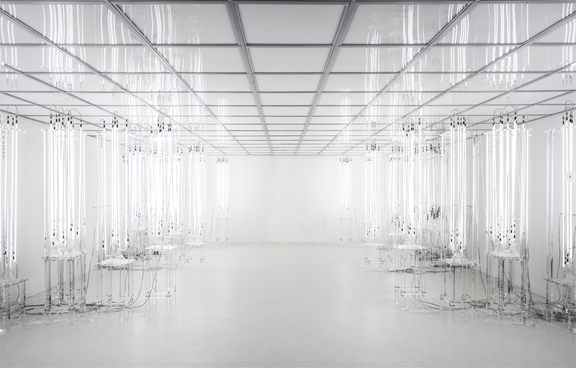
|
| Loris Gréaud, Does The Angle Between Two Walls Have a Happy Ending?, 2013. |
The
55th Venice Biennale by Deanna Sirlin
The Venice Biennale has always been a kind of delight for me,
a time to travel to the beautiful city of Venice to immerse myself in contemporary art in the water-based place where so much
art was both conceived and born.
The North American team from The Art Section arrives in Venice on Sunday, earlier than most of the art critics,
but we are only a small team and we wish to meet up with our correspondents from Europe to decide who will be writing about
what, deadlines, photos and the rest.
So
on Day One, we do not yet have access to the Biennale but many collateral exhibitions are about to open. We begin at the Fondazione
Querini Stampalia with an installation by Jacob Hashimoto hung from the ceiling of this attic space are almost 10,000 elliptical
kites. The work, Gas Giant, is all lightness and air, with delicate drawings and primary color swatches filling the
space. I had seen Jacob’s work thirteen years ago at Studio La Città in Verona where his dealer, Hélène de Franchis,
had introduced me to it. I must say I was dismayed to see that his work has not developed much in the past decade. We met
the American artist, who acknowledged his good fortune to be invited to create installations in places like this. He seemed
happy with the installation and he told us about his new New York dealer, Mary Boone. He also told us about his seven assistants
who glue and paint and wire to the many modular pieces. Jacob Hashimoto is indeed charming and charmed, all the more so because
he readily acknowledges his success. I only wish all this promise would take off in some way.
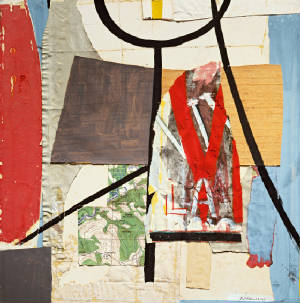
|
| Robert Motherwell, View from a High Tower, 1944-45. Photo: Peggy Guggenheim Collection. |
The Peggy Guggenheim Collection, a small jewel of a museum,
is across the canal and we take the vaporetto or waterbus. The garden of the museum is cool and green with many sculptures
that I love, especially the Jenny Holzer benches, which are ageing well. The texts seem more poignant than ever. But
we are here to see Robert Motherwell’s early collages. I had been working in collage all year without giving Motherwell
a nod, and here are works from 1944. The works are where Motherwell claims he found his identity. I have always thought certain
works from this period were very significant to him especially in his color, the ochre and grayed out cerulean blue that really
come into play so brilliantly in this exhibition. I think of these colors as belonging to Motherwell; he reinvented them in
these collages. The presence, quality and opacity of the oil paint on the paper and the physical sense of these works are
very strong.
Next on our agenda is the Pinault
Collection at Punta della Dogana, a beautiful space filled with troubling works of art in an exhibition titled Prima Materia.
Okay, so with that title you can do anything you want. Anyway, this show sort of gave me an early morning headache because
the juxtaposition of particular works seems like a forced dialogue rather than a natural conversation. For instance, Sherrie
Levine’s beautiful clear glass skulls each in its own exquisite vitrine were nearby an installation of searing bright
white light by Loris Gréaud, Does The Angle Between Two Walls Have a Happy Ending?, 2013, while in the next gallery
were some big juicy landscape paintings by Zeng Fanzhi. At 98 1/2 × 413 7/10 inches, This Land so Rich in Beauty no.1,
2010, is a huge work that blends Western ideas of oil painting With eastern ideas of fluidity and landscape. These are three
of many quite fabulous works of art in the show, but they do not have much in common.
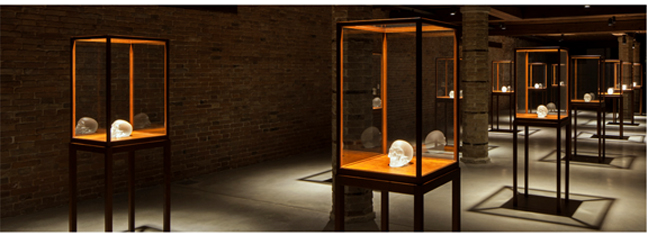
|
| Sherrie Levine, Crystal Skull, 2010. |
Seeking
an antidote, we make our way over
to the Prada Foundation, which is a bit difficult to find, but we manage with a gelato stop. The exhibition When Attitudes
Become Form: Bern 1969/Venice 2013
curated by Germano Celant “in
dialogue with Thomas Demand and Rem Koolhaas,” is a reconstruction of Live in Your Head. When Attitudes Become
Form, curated
by Harald Szeemann at the Bern Kunsthalle in 1969. The four floors of objects
ranging from Sol Lewitt wall drawings to Carl Andre’s floor pieces did indeed
prove to be the antidote we sought. I smirked a bit as a viewer who had not
read the title of the show or anything about it wandered uncomprehendingly
around the gallery. However, if you did know what you were looking at, this
re-examination of an exhibition that heralded post-Pop and post-Minimalist art
worked very well, though it also pointed up how dated much of this work now
appears. At the top level, where we came in, newspapers from 1969 were laid out
to remind us of what was going on in the world at the time and of how
groundbreaking these works and this exhibition were. When I saw the show, I
walked right in but I heard that later in the week word of its significance had
taken flight by cellphone and there were lines as long as four hours to get in.
For many, visiting this exhibition was an opportunity to worship heroes.
We
did see
many other shows that day: Roy Lichtenstein and, in a separate show, Vedova at his
foundation. But not to be missed is a solo show of artist Marc Quinn curated by
Gerano Celant for the Fondazione Giorgio Cini on the island of San Giorgio
Maggiore. It is a large show with over 50 works. Although Breath is not exactly a new work since it is a replica of
Alison Lapper Pregnant, first installed
in September 2005 on the fourth plinth of London’s Trafalgar Square (2005-7),
placing it outside at the tip of the island casts new light on the artist’s
monumental work. One could see this body from many viewpoints in Venice. I had
not seen it in London or even on television at the end of the London Olympics,
but it sits so well in on this corner of the island. I find the work an icon of
beauty, even though the figure is of a woman born with no arms and severely
shortened legs (a fellow artist and friend of Quinn’s). Inside the gallery as
well, large paintings of raw butchered meat painted in a photo-realist
(although sort of a digital photo realism) style are quite beautiful in their
luscious color and movement.
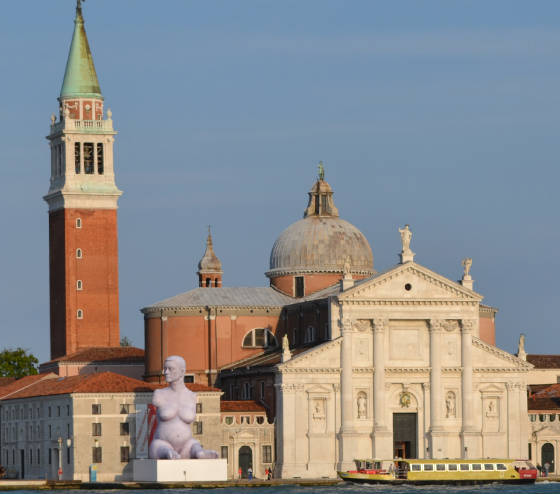
|
| Marc Quinn, Breath, 2013. Photo: Evelyn Saleh. |
On the same
Island is an exhibition of the Swiss artist Not Vital: 700 Snowballs, an installation of yes, 700 hand-blown glass
snowballs
arrayed on the floor of a long gray corridor with a mirror at the back. The
balls were blown by Murano Vetreria Pino Signoretto; the work is a
collaboration between the artist the glass studio. Each ball is very lovely
with glass surrounding a snow-like center. The installation is quite meditative
but it also evokes sinking Venice’s watery troubles.
The following day, the 55th Biennale opened to the press.
The curator Massimiliano Gioni titled
the exhibition Il Palazzo Enciclopedico/The
Encyclopedic Palace.
Massimiliano
Gioni introduced
the choice of theme evoking the Italo-American self-taught artist Marino Auriti
who “on November 16, 1955 filed a design with the US Patent office depicting
his Palazzo Enciclopedico (The Encyclopedic Palace), an imaginary museum
that was meant to house all worldly knowledge, bringing together the greatest
discoveries of the human race, from the wheel to the satellite. Auriti’s plan
was never carried out, of course, but the dream of universal, all-embracing
knowledge crops up throughout history, as one that eccentrics like Auriti share
with many other artists, writers, scientists, and prophets who have tried -
often in vain - to fashion an image of the world that will capture its infinite
variety and richness. (from the Biennale’s Website)
“The Encyclopedic Palace,” concludes Gioni, is a show that illustrates “a
condition we all share: we ourselves are media, channeling images, or at
times even finding ourselves possessed by images.”
At first I
thought, isn’t this just the idea of the Cabinet of Curiosities all over again,
an idea that dates back to the Renaissance? Is Gioni trying to erase the white
box that has proved unbreakable since Szeeman?
At the very least, there are many, many interesting works in the Palazzo--decidedly
too many to write about here .
Upon
entering the Italian pavilion one sees a large knee-high table set with a
hundred small houses made of found materials on the scale associated with toy
trains. Many of the artists included in this exhibition are outsider artists
and their work blends seamlessly with the contemporary art on show. There was a
large Jack Whitten work in tile on canvas of a pyramid shape that I like better
than any of his work I’ve seen to date.
This is not
an intellectual Biennale. This is a Biennale devoted to stuff people can look
at purely to enjoy. It dwells on surfaces.
Upstairs on
the top floor of the Italian pavilion are over 100 little unfired clay figures
in vitrines in an installation by the Swiss art team of Fusilli and Weiss. They
are representational, depicting animals and cartoon characters, but they are
set in clay backgrounds reminiscent of the natural formations in Chinese
scholars’ rocks. The installation is accompanied by two significant Dorothea
Tanning paintings.
The white
box has been eliminated, but in favor of what?
The Italian
pavilion continues in the Arsenale. It’s a huge space, filled with miles of
video, photography, painting, sculpture, and performance still under Gioni’s
curatorship and his concept of the Encyclopedic Palace. There is a new
influence of contemporary culture on the work displayed here. Bombardment of
the visual sense. Hip-hop, graffiti.
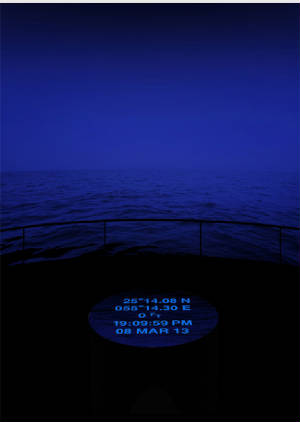
|
| Mohammed Kazem, Walking on Water, 2013. |
The
National Pavilions
For those
who have never been to the Venice Biennale, there is a giardini or garden with permanent pavilions owned by
each country. A few have been added over the years. Each country curates its
own pavilion. Our writers are covering three in this issue of The Art Section: the US, the UK, and
Macedonia. Below are a few comments on other pavilions.
There were some mysterious things that happened, one being
that the Germans and the French swapped pavilions to mark the 50th
anniversary of the Élysée Treaty between their two countries. I guess the
commissioners also think they can make art. Ravel Ravel Unravel (2013), a video and sound work by Franco-Albanian
artist Anri Sala is a punningly
beautiful work of four videos presented in two rooms. Each film is focused on
the left hand playing a piano. There is a complicated mix of both musical and
body parts that can be appreciated and listened to and seen.
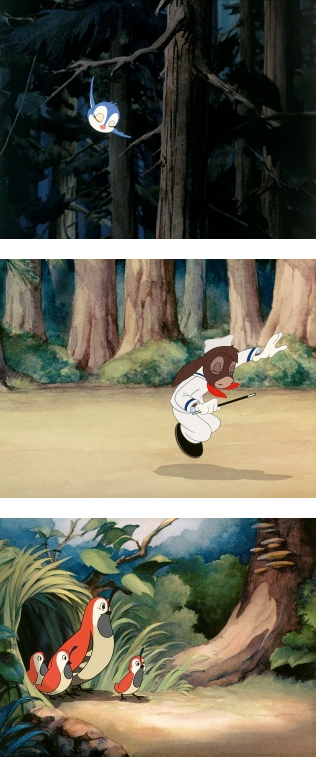
|
| Mathias Poledna, Imitation of Life, 2013. |
The
Austrian pavilion is tucked over the bridge at the back of the park. Artist Mathias
Poledna’s installation includes a three-minute animated film titled Imitation of Life in the style of classic
Disney animation. It features a donkey in a sailor suit who sings “I Got a
Feelin’ You’re Foolin’” and dances like Fred Astaire. This extraordinary and
exquisitely sounded film is playing a delicious and delightful game with us,
imitating film from the late 30’s but also making an amazing leap into the
present in the way this work was made by following and appropriating the
movements of movie dancers. There was a wonderful work on YouTube that analyzed
all the donkey’s movements and revealed their cinematic sources, but it appears
they were asked to take it down. More’s the pity… knowing more about the
relationship of Poledna’s film to its sources only enhances appreciation of it.
The new UAE
Pavillion with an up escalator is in a building in the Arsenale. Walking on Water features a commissioned
installation by Mohammed Kazem, a 360-degree projection of a very intense blue
ocean. You enter the space and you feel like you are at sea. The artist wants
you to feel lost at sea, symbolically breaking down geographical barriers.
However, I thought the work was simply about being on a boat in the middle of
this wonderful cobalt colored movement of water and--no pun intended--to be
immersed in its beauty. At the end of the day, isn’t this enough?
There are eighty-eight
pavilions at the Biennale this year, including ten new ones. So some ideas here are to be continued….
The 55th
Biennale is on view until November 24, 2013.
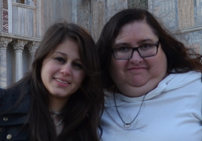
Deanna Sirlin, Editor-In-Chief of
The Art Section and Evelyn Saleh, Biennale Photographer. Evie will be starting her art career at Georgia State University
in the Fall. Deanna Sirlin recently published a book, She's
Got What It Takes: American Women Artists in Dialogue with Charta Art Books www.deannasirlin.com
|
